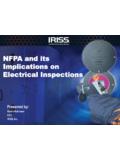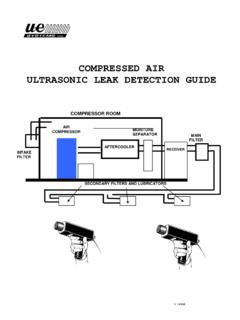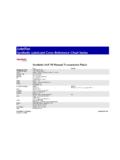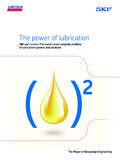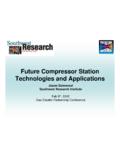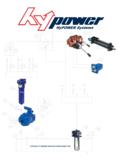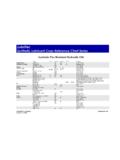Transcription of By Alan Bandes, Vice President, UE Systems, Inc. “As many ...
1 Ultrasound Assisted lubrication By Alan Bandes, Vice President, UE Systems, Inc. As many as 60 to 80 percent of all bearing failures ( catastrophic , functional and premature) are lubrication -related, whether it's poor lubricant selection, poor application, lubricant contamination or lubricant degradation. - NORIA Corporation The most influential cause of bearing failure is lubrication related. Using improper lubricant can damage a bearing to the point of irreversible failure , causing machine and production shutdown, lost hours and significant downtime. Bearings running with too little lubricant can cause friction requiring more energy to overcome resistance, which can lead to bearing failure and eventual seizure.
2 Using too much lubricant can also produce heat, break seals and decrease acceptable tolerances leading to bearing failure . In order to reduce premature bearing failure incidents many companies around the world have incorporated some form of a condition monitoring program. As opposed to the other forms of maintenance, such as reactive in which a failure condition has occurred and maintenance personnel must "react" to the problem; or preventive where maintenance activities are performed on a set schedule, condition monitoring is used to check the health or "condition" of operating equipment.
3 Any change in monitored fields can alert maintenance personnel of potential failure and allow the repair to be performed on a scheduled, controlled basis. lubrication : what is too much vs. too little? While many bearings can fail due to lack of lubrication , over- lubrication is considered one of the major causes of bearing failure . While standard preventive time-based procedures may be useful, if this practice is followed without any feedback regarding the condition of a bearing , it may, in fact, lead to over- lubrication conditions. For this reason many maintenance departments are switching to a combination of preventive and condition-based lubrication .
4 A condition-based lubrication program requires a combination of trending bearing decibel levels and basic sound analysis. A baseline decibel level is set, along with (if possible) a baseline sound sample, and an inspection schedule is established for periodic testing. When a bearing sound level exceeds 8 dB with no change in the sound quality (usually a smooth, rushing sound), the bearing is considered in need of lubrication . A lubrication technician, while listening to the bearing , will then apply lubricant, a little at a time, until the sound level drops.
5 Stopping at that point prevents over- lubrication . Case in Point A maintenance manager for a food manufacturing plant reported at a recent ultrasound conference a savings of $220,000 in their bearing - monitoring program. The company also reported that since initiating ultrasound condition monitoring at another of their facilities more than three years ago, there have been no unannounced failures in the 340 bearings they monitor, and that their motor repair cost was reduced from $2400 to $600 per motor. In fact, all their criteria for rebuilding a motor are based on condition rather than preventive, time-based procedures.
6 This switch has resulted in a three-fold savings, which translates into $90,000 per year. Another maintenance manager reported that since the inception of using ultrasound as their facility they went from an average of 27 rotating equipment failures a year to no rotating equipment failures in three years. Examples of over lubrication on right and under lubrication above. How can ultrasound technology provide such accurate results? During inspection using airborne/structure borne ultrasound, the inspector will sense friction in mechanical equipment.
7 Trending associated amplitude levels and changes in sound quality of a bearing will indicate fault conditions, including lack of lubrication . Some of the more sophisticated bearing inspection programs incorporate a two-phased approach. Bearings are routinely tested with an ultrasound instrument as part of a condition monitoring activity. Data is stored, sound samples are analyzed (when necessary). When a report is generated, those bearings in need of lubrication are identified and a work order is issued. The second phase of the program incorporates the use of the specialized ultrasound grease-assist instrument by the lubrication technician.
8 Conclusion The benefits of ultrasonic condition monitoring are quite substantial. From identification of bearings in need of lubrication to prevention of over- lubrication , ultrasound instruments can reduce the amount of grease needed in inventory, improve asset availability and most importantly, improve the bottom line. The blue line passes over the yellow line, indicating low a lack of lubrication . (Side Bar information) Beyond accuracy, what are the advantages of ultrasound related to lubrication analysis? The basic advantages of ultrasound and ultrasonic instruments are: 1.
9 Ultrasound provides early warning of impending mechanical failure . 2. Isolates Signal to a specific test point. 3. Can determine the quality of a bearing . 4. Can detect exact lubrication needs ( add or stop adding lubricant) 5. The instruments can be used in loud, noisy environments. 6. Can be used on slow speed bearings. 7. They support and enhance other PDM technologies or can stand on their own in a maintenance program. ----- UE Systems, Inc. 14 H ayes Street Elmsford, NY 10523 PH: +914-592-1220 TF: 800-223 -1325 E: W.



